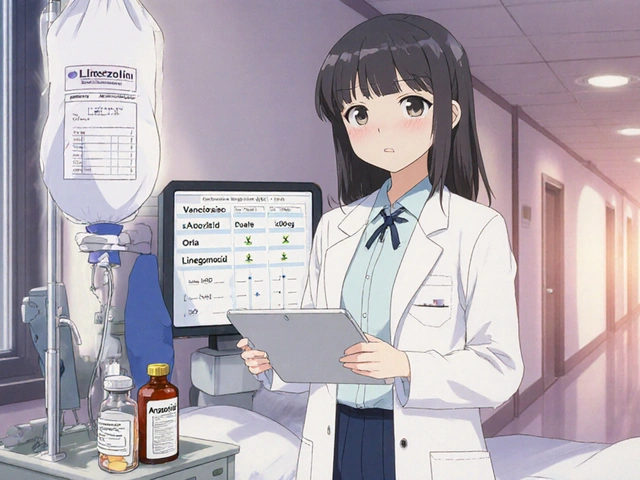Clomid gets a ton of attention when it comes to helping with ovulation, but it's definitely not the only game in town. Maybe Clomid didn’t work for you, maybe you didn’t like the side effects, or maybe you just want more options on the table. Either way, knowing what else is out there can be a total game changer if you're trying to boost your fertility or tackle a stubborn case of PCOS.
Here’s the honest truth: every option has its own list of pros and cons. Some are prescription meds. Others are more natural, or even changes you can make to your daily routine. The point isn’t to pick a perfect cure—but to find something that actually fits your life, your health, and your wallet.
If you’ve ever felt overwhelmed while scrolling through random forums or trying to make sense of medical jargon, you’re in the right place. We’ll break down how each alternative works, what you can realistically expect, and a few facts no one tells you at the pharmacy counter. Ready to ditch the confusion? Let’s get into it.
- Letrozole (Femara)
- Gonadotropins
- Tamoxifen
- Metformin
- Aromatase Inhibitors (non-Letrozole)
- Inositol
- Black Cohosh (Cimicifuga racemosa)
- Lifestyle Changes
- Summary Table: How the Alternatives Compare
Letrozole (Femara)
If you’re nervous about Clomid side effects or just want a better shot at ovulating, Letrozole (Femara) is worth a look. This drug was originally designed for breast cancer, but doctors noticed it could kickstart ovulation—so these days, it’s a legit first-choice for women dealing with PCOS or who haven’t had much luck with Clomid.
Letrozole is part of a group called aromatase inhibitors. That’s tech-speak for meds that lower estrogen just enough to nudge your brain into pumping out more FSH (follicle-stimulating hormone). More FSH usually means your ovaries wake up and start working on those crucial egg follicles. Sounds technical, but all you really need to know is this: it helps you ovulate by fooling your body into making the hormones you need.
Why do doctors suggest it? Because, according to several well-run studies, Letrozole actually beats out Clomid for women with PCOS. In a 2014 study published in the New England Journal of Medicine, the live birth rate for women with PCOS on Letrozole was 27.5%, compared to 19.1% for Clomid. That’s a solid jump in success.
| Drug | Live Birth Rate (PCOS) |
|---|---|
| Letrozole | 27.5% |
| Clomid | 19.1% |
You usually take Letrozole as a pill once a day for five days, early in your cycle. Most women start with a low dose, but your doc might tweak it if you don’t ovulate the first time.
Pros
- More effective than Clomid for PCOS ovulation (higher live birth and ovulation rates).
- Lower risk of twins compared to Clomid, because it usually causes only one mature egg to release.
- Shorter half-life than Clomid, so side effects tend to go away faster.
- Oral pill—no injections or complicated routines.
Cons
- Still prescription-only, so you’ll need your doctor on board.
- Some women get hot flashes, headaches, or fatigue while taking it.
- Not everyone responds—just like with Clomid, there’s no guarantee it’ll work.
- Can mess with your menstrual cycle timing, making ovulation predictions tricky the first month or two.
If Clomid isn’t getting you anywhere, or if you just want something with solid science backing it up, Letrozole is a strong contender among Clomid alternatives. It’s not magic, but for a lot of women, it’s a real step forward.
Gonadotropins
If Clomid didn't do the trick, doctors often bring up gonadotropins. These are injectable hormones that actually kick your ovaries into gear by directly telling them to mature and release eggs. It’s not a pill. It’s usually a small needle in your belly or thigh—definitely a step up from the usual oral meds people expect from their fertility treatments.
Gonadotropins are super common at fertility clinics—especially if you’ve tried things like Clomid alternatives and still didn’t ovulate. Common names you’ll see: FSH (follicle-stimulating hormone), LH (luteinizing hormone), or brands like Gonal-F, Follistim, and Menopur. Doctors actually monitor you pretty closely on these, and you'll probably have regular ultrasounds and blood tests to track how things are going. This isn’t a do-it-yourself treatment; you need a fertility specialist in your corner.
They’re effective, with studies showing ovulation rates between 70% and 90% in people with PCOS and unexplained infertility. But they’re not risk-free, and there’s a bit more to juggle compared to popping a daily pill—especially the risk of multiple pregnancy (think twins, triplets, or more) and something called OHSS (ovarian hyperstimulation syndrome), where your ovaries go a bit overboard.
- Pros
- Higher ovulation and pregnancy rates compared to Clomid, especially for stubborn cases
- Works even if your body is resistant to oral fertility meds
- Customizable dosing: Doctors can ramp it up or tone it down based on your response
- Cons
- Cost can skyrocket—think hundreds to thousands per cycle (insurance may not cover everything)
- Not as simple as a daily pill; it’s shots, doctor visits, and monitoring
- Boosts your odds of multiples: about 20% chance, mostly twins
- Higher risk of OHSS, which can land you in the hospital if things really get out of hand
Check out the quick numbers below to compare some facts:
| Treatment | Ovulation Rate | Average Twins Rate | Cost per Cycle |
|---|---|---|---|
| Clomid | 80% | ~8% | $10–$100 |
| Gonadotropins | 70–90% | ~20% | $1000–$5000 |
If you’re serious about moving past oral meds and you’re working with a specialist, gonadotropins could be the next step worth talking about.
Tamoxifen
If you’ve ever heard about breast cancer treatments, you’ve probably bumped into the name Tamoxifen. But here’s the thing—Tamoxifen isn’t just for cancer; it’s actually a solid alternative to Clomid when it comes to fertility, especially for women who don’t ovulate regularly.
Doctors sometimes turn to Tamoxifen when Clomid doesn’t do the trick or when someone just can’t tolerate the side effects. It works in a similar way: it tells your body to make more hormones that trigger ovulation. But there’s a twist—some studies show Tamoxifen causes less thinning of the uterine lining compared to Clomid, which might be good news if you’ve had issues with that before.
If you’re allergic to Clomid or don’t respond to it, Tamoxifen could be your next step. It’s often used off-label for this purpose, mostly in women with PCOS or unexplained infertility. The usual dose for fertility treatment is pretty similar to Clomid, usually 20-40mg per day for five days early in your cycle, but always follow your doctor’s instructions.
Pros
- Tends to thin the uterine lining less than Clomid (which can help with implantation).
- Can work for women who didn’t ovulate with Clomid.
- Less risk of causing ovarian cysts compared to some other medications.
- Can be a good choice for those with PCOS or people sensitive to Clomid.
Cons
- Still a prescription drug, so you need a doctor involved.
- Possible side effects: hot flashes, mood swings, and very rarely, blood clots.
- Not as much data behind it for fertility as there is for Clomid, but it’s catching up.
- Insurance may not always cover it for fertility treatment since it’s off-label.
Here’s a quick look at how Tamoxifen compares to Clomid on some key issues:
| Feature | Clomid | Tamoxifen |
|---|---|---|
| Ovulation Rate | 70-80% | 60-75% |
| Thinning of Uterine Lining | Common | Rare |
| Risk of Cysts | Higher | Lower |
At the end of the day, Tamoxifen is a real option for folks who need a break from Clomid alternatives. Just make sure to have a good chat with your doctor, weigh out the risks, and see what fits your situation best.
Metformin
Metformin isn’t just for folks with type 2 diabetes. It’s also a pretty well-known Clomid alternative for people dealing with PCOS or insulin resistance when trying to get pregnant. Doctors often try it if you’ve got irregular cycles, or even if you’ve tried Clomid and it didn’t work as planned.
Here’s the science: Metformin helps the body use insulin more effectively. For people with PCOS, better insulin sensitivity can mean more regular periods and a shot at natural ovulation. Often, Metformin is either used alone or alongside other fertility meds. In fact, some clinics see ovulation happening in up to 45% of PCOS patients after a few months on Metformin. That’s not magic, but it’s not nothing.
If you’re not a pill person, here’s a heads up: Metformin is taken by mouth, usually once or twice a day. It’s generally safe, but some folks deal with side effects like stomach upset or diarrhea, especially when they first start taking it. You can usually avoid the worst of it by starting at a low dose and creeping up slowly.
Pros
- Targets the root cause in insulin-resistant PCOS, not just symptoms
- Can restore regular menstrual cycles
- Promotes ovulation in many patients (especially when combined with other drugs)
- May help with weight loss and lower risk for gestational diabetes
- Widely available and pretty affordable
Cons
- Common gut side effects like nausea, gas, or diarrhea
- Not a miracle drug—does not work for everyone
- Has little impact for people without insulin resistance
- Takes a few months to show results in some cases
- Needs to be taken daily, sometimes for a long stretch
Want a quick look at how Metformin fits compared to Clomid in terms of ovulation success rates?
| Treatment | Ovulation Rate (%) | Works for PCOS with Insulin Resistance |
|---|---|---|
| Clomid | ~70-80% | Sometimes |
| Metformin | ~45% | Best suited |
Metformin may not work for everyone as well as Clomid, but if you have insulin resistance, it could be the trick your body is actually waiting for.

Aromatase Inhibitors (non-Letrozole)
You probably hear a lot about Letrozole when looking at clomid alternatives, but it’s not the only aromatase inhibitor out there. Others—like Anastrozole (marketed as Arimidex)—also show up as fertility game plans, especially in tough cases where Clomid and Letrozole just haven’t done the trick.
Aromatase inhibitors work by blocking the conversion of androgens into estrogen, which tells your body to pump out more FSH (follicle-stimulating hormone). More FSH basically means a better shot at ovulation. The big difference from Clomid? These meds usually don’t thin out the uterine lining, a classic Clomid side effect that can mess with implantation.
Why would a doc reach for a non-Letrozole aromatase inhibitor? Sometimes it’s because of allergies, intolerances, or just bad side effects with Letrozole or Clomid. The science is sure: a few small studies show that Anastrozole can work, especially for women with polycystic ovary syndrome (PCOS) or unexplained infertility. There isn’t a mountain of research yet, and this option hasn’t become first-line in most clinics, but it’s there and it’s being tried.
Here’s a quick look at how non-Letrozole aromatase inhibitors like Anastrozole measure up when it comes to fertility treatments:
- Similar way of boosting FSH as Letrozole but potentially fewer side effects on the uterine lining.
- Doses are usually lower than in breast cancer management—so typical side effects like bone loss are not a big worry for short cycles.
- Usually given for 5 days early in the period, just like Clomid.
Tidbit: In a small Indian trial in 2022 with 120 women who had PCOS, ovulation rates with Anastrozole clocked in at about 65%, while Letrozole had slightly higher numbers—around 76%. Pregnancy rates were similar, but some users reported fewer headaches and hot flashes.
Pros
- Won’t thin the uterine lining like Clomid sometimes does
- Potentially fewer estrogen-related side effects
- Can be a backup if Letrozole or Clomid cause rough side effects
- Short treatment cycles mean fewer long-term risks
Cons
- Much less research than Clomid or Letrozole
- Not widely used as the first or even second option—can be harder to access
- Insurance may not cover off-label prescriptions
- Some women still get headaches, mood swings, or mild bloating
If you’re considering alternatives to Clomid, these non-Letrozole aromatase inhibitors are a good topic to actually bring up with your OB or fertility doc, especially if prior meds haven’t been friendly to your system.
Inositol
When it comes to Clomid alternatives, inositol has been getting more buzz lately—especially among people with PCOS. It's not some mysterious, hard-to-find pill; inositol is actually a type of B-vitamin-like compound that your body uses every day. You mostly see it in two forms for fertility: myo-inositol and D-chiro-inositol. They both show up as over-the-counter supplements, and you don’t need a prescription to buy them online or in stores.
So, why do people talk about inositol? If you’re dealing with irregular cycles or trouble ovulating (thank you, PCOS), research hints that these supplements can help make your menstrual cycle more regular. Some studies found that taking myo-inositol (sometimes mixed with D-chiro-inositol) can jumpstart ovulation in women who aren’t responding to meds like Clomid.
One cool part is how inositol tackles insulin resistance. People with PCOS usually have higher insulin levels, which mess with hormones and make ovulation harder. Inositol helps balance out your insulin, and that positive chain reaction can mean improved fertility over time.
| Inositol Type | Common Dosage/Day | Key Benefit |
|---|---|---|
| Myo-inositol | 2000-4000 mg | Supports ovulation, improves insulin sensitivity |
| D-chiro-inositol | 50-100 mg (often taken with myo-inositol) | Helps hormone balance |
People usually like inositol because it tends to have fewer side effects than prescription drugs for fertility treatments. Upset stomachs or loose stools are possible, but it’s generally easier on the body compared to the headaches, mood swings, or vision problems that can pop up with Clomid.
Pros
- Can improve ovulation and menstrual regularity, especially in PCOS
- Over-the-counter, no prescription needed
- Usually fewer side effects compared to fertility drugs
- Supports both hormonal and metabolic balance
Cons
- Works best for people with PCOS; results are mixed for other causes of infertility
- Supplements aren't always regulated—a trustworthy brand matters
- Some people notice no effect at all, and it may take months to see changes
If you're thinking about trying inositol, talk with your doctor about dosage and make sure the supplement is tested for quality. It might feel slow compared to popping a single pill, but for some, steady progress is worth it.
Black Cohosh (Cimicifuga racemosa)
If you’re leaning toward something natural on your fertility journey, Black Cohosh grabs a lot of attention. This herbal remedy comes from a North American plant and has been used for ages to help with women’s health—mostly for menopause, but also for folks struggling with ovulation, especially those with PCOS.
Here's the interesting part: a few small studies suggest Black Cohosh might help improve your LH/FSH ratios (the main hormones your brain uses to talk to your ovaries) and kick up your progesterone levels after ovulation. That’s critical for folks who have trouble releasing an egg each month. Some doctors in Europe even recommend pairing it with prescription fertility meds to give things an extra nudge.
Now, nobody’s pretending that Black Cohosh is as well-researched as Clomid alternatives like Letrozole or prescription hormones, but people who want a gentler approach (or have gotten nowhere with meds) sometimes give it a shot. But let’s break down what you’re actually getting into:
Pros
- Natural—no prescriptions necessary and it’s plant-based.
- Lesser-known side effects compared to some fertility meds. Most report only mild stomach upset or headaches, if anything.
- May gently support hormone balance in PCOS or irregular cycles.
Cons
- Quality can be all over the place—supplements are not regulated like medicines.
- Actual proof in humans is pretty limited. Most studies are small or not super rigorous.
- You don’t get dosing consistency. What you get in one bottle might be way different from the next.
If you’re thinking about trying Black Cohosh, talk to your healthcare provider first, especially if you’re already on prescription fertility treatments, have liver issues, or take other meds. Sometimes, mixing herbs and medicines can throw things off.
| What to Watch | Details |
|---|---|
| Usual Dose | 20-120mg daily (tablet or capsule) |
| Main Use | Menopause, PCOS-related ovulation issues |
| Most Common Side Effect | Headache, mild stomach upset |
| Can you combine with Clomid? | Some specialists do, but only under medical guidance |
Bottom line with Black Cohosh: if natural appeals to you and you’re willing to be patient, this herbal route might be worth a shot. Just make sure you’re realistic—results can be hit or miss. Don’t skip regular check-ins with a provider just because you’re going the herbal route.
Lifestyle Changes
If you're not keen on medication or just want to stack the odds in your favor, lifestyle changes can actually make a difference for folks dealing with ovulation issues or fertility treatments. Now, let's be real—no lifestyle hack acts as a perfect swap for meds like Clomid. But when it comes to PCOS options and even mild ovulation problems, the results can be surprisingly decent.
A few targeted changes have pretty strong science behind them. For example, women with a body mass index (BMI) over 30 are statistically twice as likely to struggle with ovulation. If you bring your BMI down just 5-10%, you can jumpstart regular cycles in a big chunk of cases. Not magic—just basic biology. Here’s what really counts:
- Weight management: Even a modest drop in weight can restore ovulation for many people with PCOS. You don’t have to go extreme.
- Regular exercise: Aim for at least 30 minutes of moderate movement (walking, cycling, swimming) about 5 days a week. It’s more about consistency than perfection.
- Balanced diet: Low-glycemic foods (think whole grains, lean protein, and veggies) help cut insulin spikes that mess with hormones. Processed junk and massive carb loads are the enemy here.
- Cutting out smoking and limiting alcohol: Lighting up can halve your chances of getting pregnant per cycle. Excess drinking isn’t great for egg quality, either.
- Stress reduction: Easier said than done, but high stress equals more cortisol, and more cortisol equals chaos for reproductive hormones. Try yoga, guided meditation, or even just 10 minutes of daily downtime.
Doctors see these changes help so often, they’ll usually suggest them even before writing a prescription. Sometimes, though, you need something extra. The catch: not everyone gets the same results, and for some, PCOS or ovulation problems are stubborn no matter how many salads you eat or steps you track.
Check out these stats from a review of lifestyle interventions in fertility clinics:
| Intervention | Odds of Ovulation after 6 months |
|---|---|
| Weight Loss (5-10%) | ~60% |
| Exercise Only | ~35% |
| Diet Changes Only | ~30% |
Short version? If you’re considering alternatives to Clomid, dialing in your routine is smart, whether or not you go for meds later. For some, that nudge is all it takes to get cycles back on track or bump up fertility treatment success rates.

Summary Table: How the Alternatives Compare
When you're comparing Clomid alternatives, it's tough to keep all the details straight in your head. That's why this chart lays it all out—side effects, what the meds actually do, who's a good candidate, and how tough they are on your wallet. Real talk: your best pick will depend on your health history, fertility goals, and how you feel about things like injections versus pills, or natural versus prescription options.
Here's a look at how the most common fertility treatments and natural routes stack up:
| Alternative | Type | How It Works | Main Pros | Biggest Cons | Cost Range |
|---|---|---|---|---|---|
| Letrozole (Femara) | Prescription Pill | Lowers estrogen to trigger FSH for ovulation | Higher live birth rates in PCOS, fewer multiples vs Clomid | Headaches, dizziness, not all doctors prescribe | $20–$100 per cycle |
| Gonadotropins | Hormone Injection | Directly stimulates ovaries | Great for tough cases, high chance of response | Costly, needs monitoring, higher risk of twins/triplets | $1000–$5000+ per cycle |
| Tamoxifen | Prescription Pill | Blocks estrogen, triggers hormones for ovulation | Good if Clomid causes lining issues, similar results | Hot flashes, less commonly used in fertility | $50–$200 per cycle |
| Metformin | Prescription Pill | Lowers insulin, helps hormones for ovulation | Helps PCOS with insulin resistance, supports weight loss | GI issues, slow results for some (months) | $10–$50 per month |
| Aromatase Inhibitors (non-Letrozole) | Prescription Pill | Blocks estrogen production, similar action as Letrozole | Might help if Letrozole/Clomid fails, fewer side effects | Limited research, not first line | $50–$150 per cycle |
| Inositol | Supplement | Improves ovary function & insulin sensitivity | Natural, helpful in PCOS (esp. with Metformin), easy to use | Needs months for effect, not strong enough for all cases | $20–$60 per month |
| Black Cohosh | Herbal | Balances LH/FSH, supports progesterone | Natural, fewer side effects, easy to get | Quality can vary, limited science, not standardized | $10–$40 per month |
| Lifestyle Changes | Non-medical | Diet, exercise, stress reduction | Improves hormone balance, boosts overall chance | Slow results, doesn’t work for everyone | Free–cost of gym/food |
If you're still feeling lost, here's what usually tips the scales for most people:
- PCOS? Letrozole, Metformin, and Inositol are usually top picks. They work well alone or even together.
- Failed on Clomid? Letrozole or injectable gonadotropins might help, but they do cost more and require more doctor visits.
- Want the most natural fix? Black Cohosh and lifestyle shifts are the least likely to cause harsh side effects, but don’t expect miracles overnight.
- If time is not on your side (age, other fertility issues), sometimes jumping straight to stronger prescription meds or injections gives you the best shot.
Bring these points to your OB-GYN or fertility doc. The main thing is there’s no one-size-fits-all. The good news? There's almost always another path forward, even if Clomid wasn’t a fit.







11 Comments
Honestly, diving into alternatives to Clomid can feel like navigating a maze where every turn promises something better yet comes with its own baggage. This guide seems like a breath of fresh air because it doesn't just glorify these options, it lays bare the good, the bad, and the downright tricky aspects of each. The thing is, so many people jump on Clomid without fully appreciating what else is on the table or understanding the potential side effects, so having a no-nonsense rundown is refreshing.
It’s essential to look at these alternatives not just from a medical perspective but considering personal circumstances too. For example, some might lean toward natural routes simply because they prefer avoiding synthetic hormones, while others might prioritize effectiveness over everything else. The challenge is balancing hope with realistic expectations.
Also, the bit about saving time and avoiding surprises hits home. Fertility journeys can already drain you emotionally and physically, so anything that lightens the load is a win. I do wonder, though, how well the guide addresses those subtle nuances, like how different bodies might react or the long-term implications of some medications.
This post is EXACTLY what people need! It's frustrating how often Clomid is just thrown at women as the default with little explanation or alternative discussions. There are legit alternatives out there, and knowing the pros and cons ahead of time is empowering. No one should have to walk into a fertility plan blind or feeling they’ve got only one shot at success.
Sometimes, people overlook natural options because they’re marketed less aggressively, but honestly, the more informed you are about everything, the better choices you can make. And yeah, it can get overwhelming, but breaking it down like this guide does? That’s a game changer.
For anyone frustrated with Clomid or worried about side effects, this is your sign to look deeper and advocate for yourself. Don’t settle for a one-size-fits-all approach — you’ve got options!
Look, I get it. Everyone’s desperate for answers in this fertility game. But here’s the thing: meds like Clomid and its alternatives are not magic bullets; they’re band-aids for a bigger issue. Society’s obsession with pushing fertility drugs ignores the root causes and the natural rhythms of the human body. If you really want success, you’ve got to think bigger than just swapping pills.
That said, this guide is useful in cutting through the noise and laying out the facts sans fluff. But while it covers the pros and cons, it doesn’t challenge the dominant medical narrative enough. We need to ask why these drugs are the first stop instead of the last.
Anyway, if you’re here to learn what these alternatives are, cool, but don’t buy the hype that they’re the answer to everything. It’s a starting point, not a finish line.
Oh wow!!! This is such an excitedly needed post!!! Fertility options can be SO scary and overwhelming!!!
It’s honestly refreshing to see an honest breakdown without all the dramatic hype and unrealistic promises. I think anyone navigating this journey will appreciate knowing the pros and cons upfront — that’s just kindness in written form!!
Also, it’s great to see natural alternatives getting attention alongside prescription options because sometimes our bodies just need that gentle support!!!
So much love to everyone on this path, and I hope this guide lights up some possibilities and eases some worries along the way!!! 💕💫
Reading through these options really opened my eyes. I was always stuck thinking Clomid was the only go-to, but it’s clear there’s a spectrum of choices depending on your needs and how your body reacts. It’s impressive how this guide holds nothing back — the good, the bad, and the stuff to be wary of.
That said, it makes me wonder how doctors are educating patients on these alternatives. Are patients really getting this kind of straightforward info in appointments? Because that would totally shift how people approach their treatment plans.
I’m curious — do any of you know if insurance generally covers these alternatives or do patients end up footing the bill? The financial side can be a huge factor.
Reflecting deeply on this topic, it strikes me how entwined the physical and emotional components of fertility are 🌀✨. Choosing an alternative to Clomid isn't just a medical decision but a philosophical one, almost a meditation on trust in one’s body and the healthcare systems we rely upon.
The guide's clarity is comforting amidst so many competing narratives out there, offering a tangible path through the complex forest of options 🍃🌿. What particularly resonated with me is the inclusion of natural methodologies alongside pharmaceutical treatments — an acknowledgment that fertility is not merely mechanistic but profoundly holistic.
Nevertheless, I find myself pondering how access to these alternatives varies globally and how cultural perspectives might color their reception. It’s a complex dance of biology, culture, and individual hope 😊🙏.
Honestly, I think people don't talk enough about how frustrating it can be to try multiple treatments without clear guidance. Sometimes, the alternatives to Clomid sound great on paper but in reality, they can just complicate the journey further. This guide’s straight talk is something I appreciate.
Not sure if anyone else feels this way but when you’re in the middle of it, the endless decisions can drain your energy more than the treatments themselves. I wonder if this post could start more conversations about personalized approaches rather than a trial-and-error chase.
Quality info that cuts through the noise? Sign me up for more of that.
This post is pretty informative and helpful for folks new to the fertility treatment world. I like that it speaks plainly without sugarcoating, which is rare. One thing I’d like to add is that while comparing meds is crucial, one should also consider lifestyle factors that can impact fertility before jumping into drugs.
Just my two cents from observing some friends’ experiences. Sometimes, small changes in diet, stress management, or sleep can unexpectedly tip the scales.
As someone who's been down this road, I fully appreciate the need for a comprehensive yet honest look at alternatives to Clomid. It's not just about which medication to pick but understanding the bigger picture: how your own body reacts, the emotional toll, and the societal pressures that weigh on women who are labeled as 'infertile.'
The guide's straightforward nature is a blessing because too often fertility treatment discussions get clouded by marketing or half-truths. I'm glad to see natural routes getting equal footing because sometimes less is more.
Still, this journey is deeply personal, and no guide can replace a compassionate doctor or support system, but it sure helps to be better informed 😌🌸.
Thank you for this thorough exploration of alternatives — it’s so important to consider all angles when it comes to fertility. The journey is emotionally challenging, and having clear, jargon-free info really helps to reduce anxiety and confusion. 🌼🙂
I particularly appreciate the acknowledgment of natural options, as they resonate with holistic health perspectives that many of us hold dear. 🌿💖
Does anyone here have experience combining natural methods with prescribed meds? I’d love to hear how those approaches worked together or conflicted in practice. Thank you again for opening up this conversation so thoughtfully! 😊🤗
This post is a solid resource for anyone exploring fertility treatments beyond Clomid, which is often presented as the default. I appreciate the balanced overview — it helps to demystify the options and could prompt better conversations with healthcare providers. Sometimes I see people jumping into treatments with limited info, which isn't ideal.
That being said, I'd also add that tracking how each alternative affects your body is crucial. What works well for one person might not for another, so staying attuned and patient is key. Also, open communication with your doctor can make a huge difference in navigating this complex landscape.
Overall, great guide! Encouraging people to be informed and proactive is exactly what’s needed. Thanks for sharing.
Write a comment